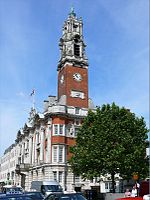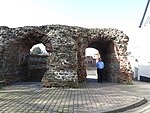Fenwick Colchester

Fenwick Colchester is a large high street department store situated in Colchester, Essex, England, formerly known as Williams & Griffin (1963–2016). Independent for much of its history, it was formed from the merger of H.E. Williams & Co Ltd (an ironmonger and agricultural machinery business) and another Colchester family business, H.L. Griffin & Co Ltd (a furnishings store), in April 1963. In 2007, Williams & Griffin won "Best Independent Department Store of the Year", sponsored by Drapers. The store was sold in March 2008 to the Fenwick chain of department stores. Current departments include beauty, fashion, toys, gifts, housewares and furniture, as well as top-floor restaurant Carluccio's.
Excerpt from the Wikipedia article Fenwick Colchester (License: CC BY-SA 3.0, Authors, Images).Fenwick Colchester
High Street, Colchester
Geographical coordinates (GPS) Address Nearby Places Show on map
Geographical coordinates (GPS)
| Latitude | Longitude |
|---|---|
| N 51.889827777778 ° | E 0.898025 ° |
Address
Fenwick
High Street
CO1 1JW Colchester
England, United Kingdom
Open on Google Maps










